And about the meaning of the different colored bands used by HawkWatch International when they’re banding kestrels.
Two days ago I told readers about a banded male American Kestrel I photographed on Antelope Island recently and I mentioned that I’d sent a couple of photos of that bird to my friends at HawkWatch International because I figured that it was likely that HWI had banded him. Both of his legs were banded and I could actually read the letters on the larger green band so I was hoping to learn more about the history of this bird.
Last night I heard back from Jesse Watson, Research Biologist and Banding Coordinator for HWI, and Jesse came through with flying colors. He told me more than I thought I’d ever know about that bird.
First, a recap of what happened in the field.
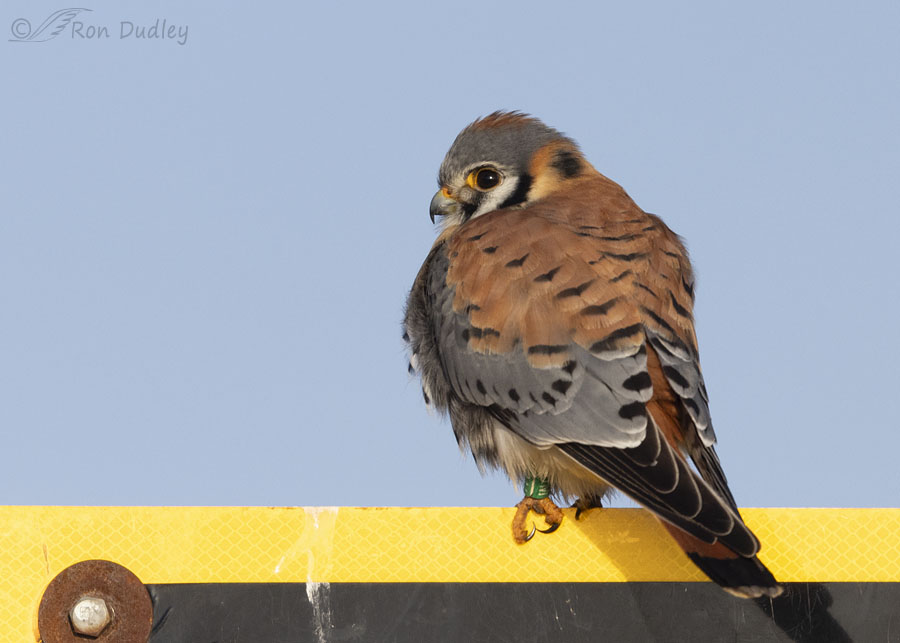
I found the male kestrel on a road sign early in the morning when it was still cold so he was pretty “sticky”, meaning he was reluctant to leave the sign. I could see that he had a green band on his left leg but I couldn’t read all of the lettering on it.
When another vehicle came along he spooked, but he…
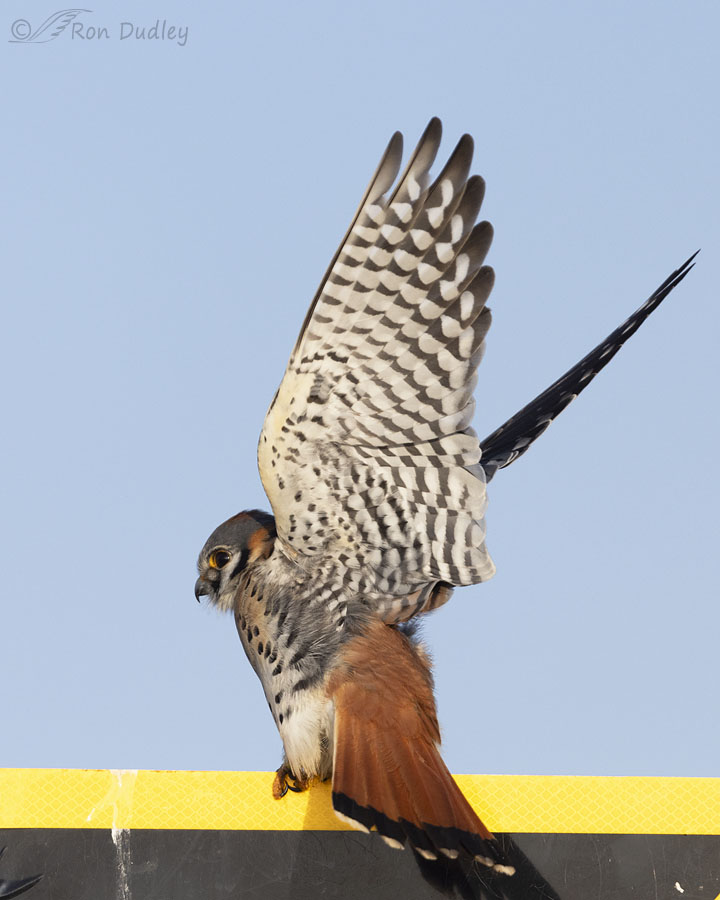
didn’t leave the sign. He just…
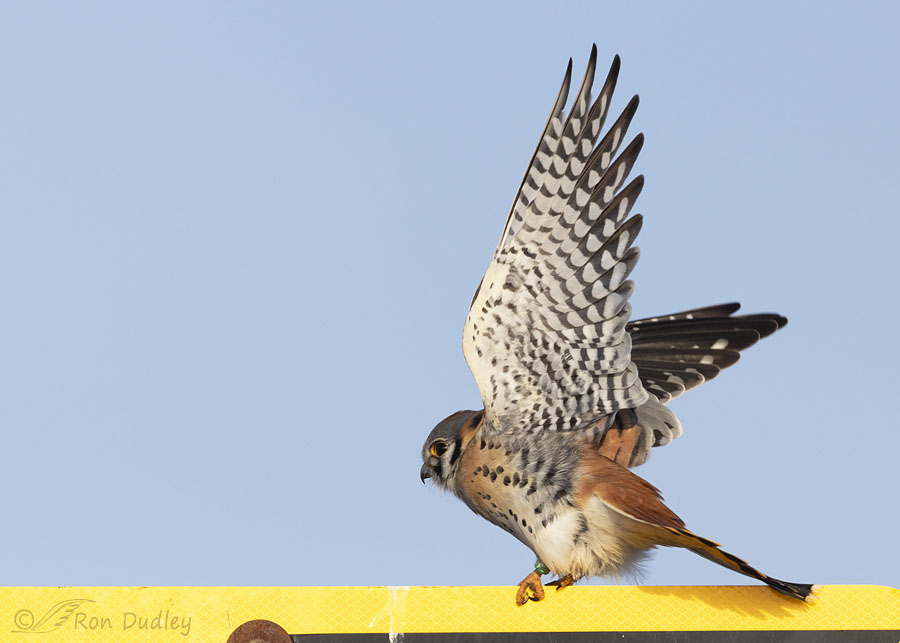
jumped to…
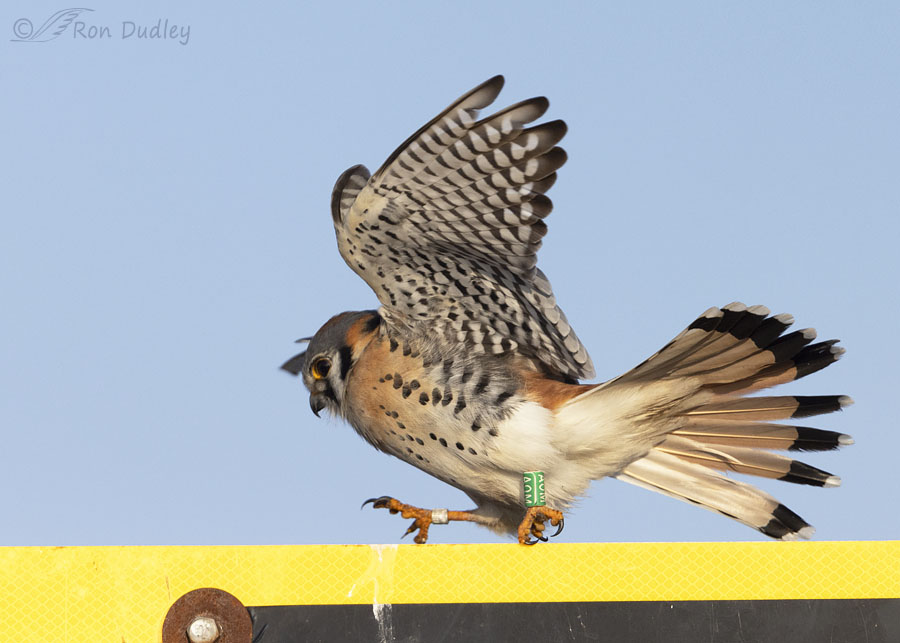
a different part of the sign. This is the only photo I got, out of many photos of him while he was on this sign and later on another sign, where I could…
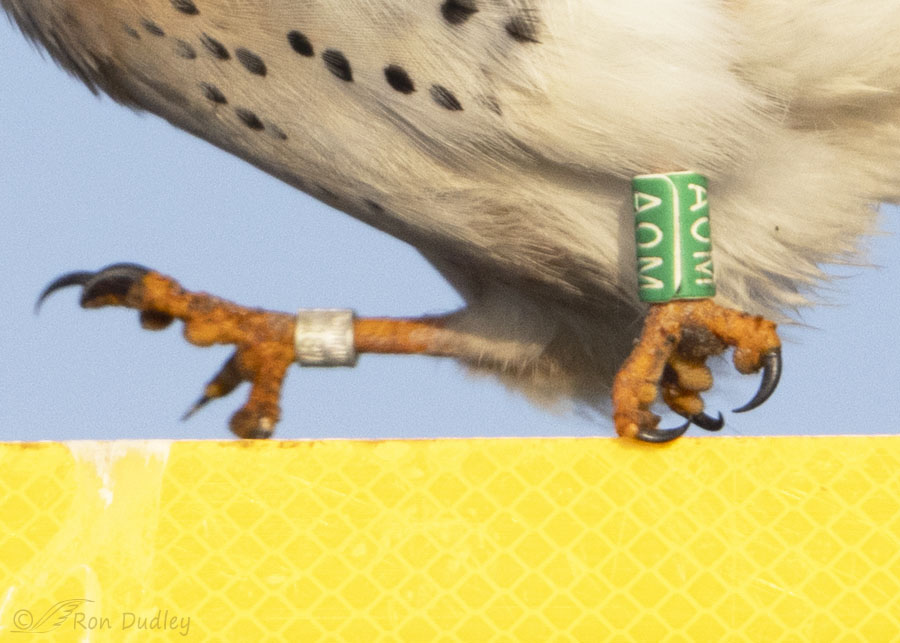
read all of the letters on the green band. And it wasn’t until this photo that I could clearly see that he was also banded on his right leg, with a smaller metal USGS band.
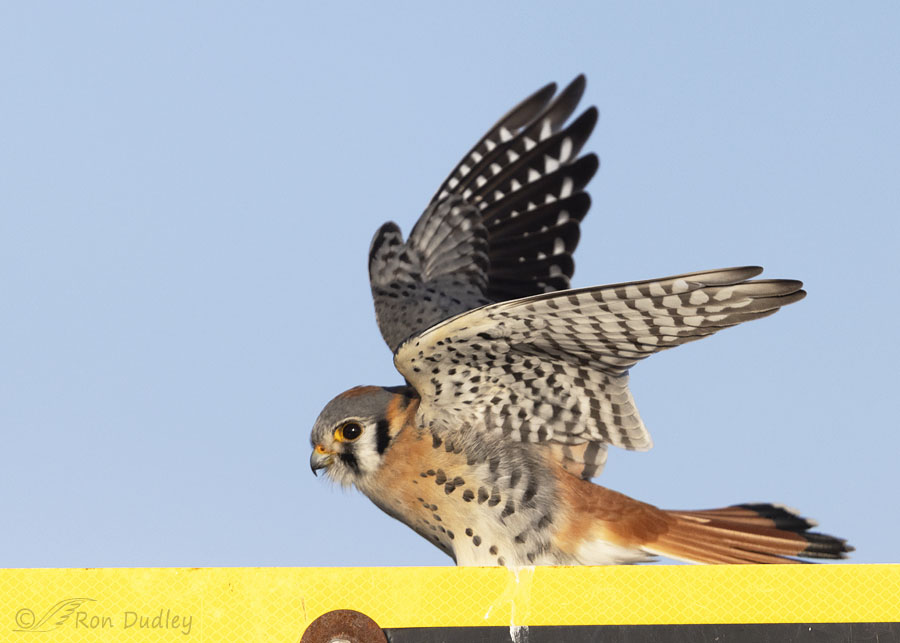
He landed behind the sign, on the top of the post supporting the sign, so now his legs and bands were completely hidden again. And they stayed hidden for the rest of the time I was with him. I just got lucky with that one shot out of many dozens.
Following is Jesse’s email to me last night. I’ve quoted him with permission.
“Hi Ron, thanks for sharing your kestrel photos. You are indeed correct that this bird was banded by HWI! For the past few years (and foreseeable future) we have been deploying these green colorbands with white lettering. The codes all contain 3 stacked letters, rotated on their side. To date, we have deployed bands starting with A or B (i.e., the top letter), though we may dip into the C’s later this year. We also deploy another color, yellow, with black lettering. Though their numbers are dwindling, there are some old colorbands (pre-2021) still being worn by kestrels in the Salt Lake Valley and those are either red, blue, or purple.
I’m sure you’re interested in some details on this kestrel. His colorband is Green AOM and his USGS band number is 1893-50584. He actually has a little bit of history, and your report allows us to continue broadening our understanding of how long he has survived and where he has moved. Jessica Taylor, a biologist on our Long-term Monitoring and Community Scientist team banded him at a nestbox on the northwest part of the island on 6.24.21 as a nestling. He was about 22 days old when banded (so he should be just about exactly 973 days old, today :)). He fledged along with 3 siblings, one female, and two males. He was the smallest at 99 grams (his siblings were all 110+ grams). Since then, he has been resighted and reported 5 times, not including your report. All on Antelope Island between February 16, 2022 and January 2024!
So, thanks to your report, we have the first record of him in 2024! We’re still hoping to figure out where he breeds…maybe this will be the year. I’m going to go ahead and submit your record to our ‘Report a banded American Kestrel’ form to add it to our growing list of records for this guy. Please consider submitting future resightings there or reaching out to us directly at kestrels@hawkwatch.org and we’ll be sure to get back to you as soon as possible. One last question, would you be alright with us using your photo in future presentations? We’ll be sure to credit/include your watermark, of course.
Thanks again!
Jesse”
Thanks, Jesse. You made yesterday, a day that was otherwise stressful for me, end on a high note.
Ron
PS – It goes without saying that I gave Jesse and HWI permission to use my photos of this kestrel for their presentations.


I was smiling unconsciously while reading all of the information about that little kestrel. I guess he’s really gotten around Antelope Island! Congrats on being his first sighting of 2024, and thanks for relaying Jesse’s information.
Great ending! I hope you do see him and his mate this year. From a safe distance for him and her (as you ALWAYS do!)
I hope so too, Arwen. I’ll definitely be looking for him. And his potential mate.
This is a wonderful story and it makes he me feel hopeful and happy.
Thank You!
Take Care,
Kaye
Glad you enjoyed it, Kaye. Thanks.
Thanks for updating on this Ron. Lots of things I didn’t know about banding, and also interesting to hear this guy’s history.
There’s a kestrel with a favorite tree in the park near my house, and now I’ll have to see if I can spot a band. “He” is pretty skittish, so good to know he might be a little “stickier” on a cold morning.
Bill, the colder the better when it comes to making them sticky.
You wrote: “it was still cold so he was pretty “sticky”, meaning he was reluctant to leave the sign.”
Great observation and fascinating logic. The colder it gets, the greater the need to avoid flying — because it loses heat and dissipates energy, and the greater the need to keep wings folded.
Robert, in my experience, kestrels seem to be affected more dramatically by the “sticky in cold” syndrome than most other birds. I don’t know why.
Thank you for the update! As Judy says, so much more than
“just a Kestrel now”. The nest cam in my brain is whirring away, imagining him in his nestbox with his siblings, growing from fluffball to fledgling. And thanks to HWI for their meticulous records. If we’re gonna interfere, nice to know it’s done well.
“And thanks to HWI for their meticulous records. If we’re gonna interfere, nice to know it’s done well.”
Well said, Carolyn.
It was so interesting to read his history….I propose his “handle”
could be “Antelope Island Homeboy” because he has stuck around
there for so long…..I’m wondering what the other–metallic– band
signifies and who might have placed it on him. He, like all of his kind,
is so very beautiful without the jewelry……..
Kris, I’m almost certain that HWI placed both bands on the bird. The facts that he has two bands, and which leg each one was placed on, helps them to ID the bird, among other things.
Very interesting Ron. I know the agencies that tag and band our birds are really interested in getting reports from birders letting them know where they have been sighted. In the past I have gotten thank you letters from the Utah and Idaho for reporting tagged Pelicans. One of our Bald Eagles who was severely injured and then rehabilitated was tagged with a solar tracker and it is amazing to see where he has traveled over the last four years. I think he was been in every western state and some northern central states. Thanks for sharing this,
Thank you, Everett. Pelicans get around, don’t they.
Neat… “thank you” for sharing with us.
(The Kestrel is one of my fav birds to spot.)
Take care,
CJ
Thanks, CJ.
Very exciting! And how nice that the smallest to fledge from that nestbox is still going strong.
Glad you enjoyed and appreciated it, Cathy. Thanks.
COOL! Glad Jesse was able to come up with some history and share it with you! So much more now than “just a KestreI” now.. 😉 Wonder what their life expectancy is? Problably highly variable. Hope WordPress starts cutting you some slack!
Thanks, Judy.
I’ve been working on the formatting problem and I think I’m getting it fixed. But I’m having to do a PITA “workaround” to make any progress.
Thanks for providing a wonderful (and informative) write up on Kestrel banding Ron. I recently asked a volunteer raptor bander to explain the benefits of banding to me and he flippantly said, “well, it helps PhD students to get data for their dissertations”. When I pressed him for a real answer, he became angry because I had the gall to even question why banding is important.
I simply like to understand the benefits of messing with the birds during the banding operations. I’m sure that it’s beneficial to science, but I also really like to understand these benefits in a little more depth. I don’t like “because I told you so” as justification.
Your explanation gives credible data on what researchers (not just PhD students) can learn about the behavior of banded birds.
Thank you Ron!
Rick, for years I’ve had the same concerns about SOME bird banding. I know that some banding is done for dubious reasons, including the one you mention.
But when it comes to banding done by HWI I know it’s done professionally and for good reason, backed by legitimate scientific research that benefits birds.
Very interesting! Each small contribution adds to the fund of knowledge about bird behavior..
Thanks, Kenneth.
Very interesting Ron. He likes to winter on Antelope Island. I wonder where he goes in the summer? I always wonder if someday (perhaps it is already happening?) we can use image analysis to identify individual birds from photographs ( maybe including UV or IR wavelengths ) or using voice signatures more. Acoustic monitoring is already being used in amazing ways for owl research. Great job on following up with the banding information.
Thanks, Ed. You definitely bring up some interesting possibilities for the future.
Great story Ron! Thanks for sharing.
Just love that the runt of the bunch is doing so well.
Bird photography is the main theme here, but between your ancestry stories, and the stories behind the photos you have taken, it is so much richer, and a lot of fun to both see and read.
Well done!
“Just love that the runt of the bunch is doing so well.”
You’re right, Michael. I didn’t even think of that “runt” twist. Wish I had.